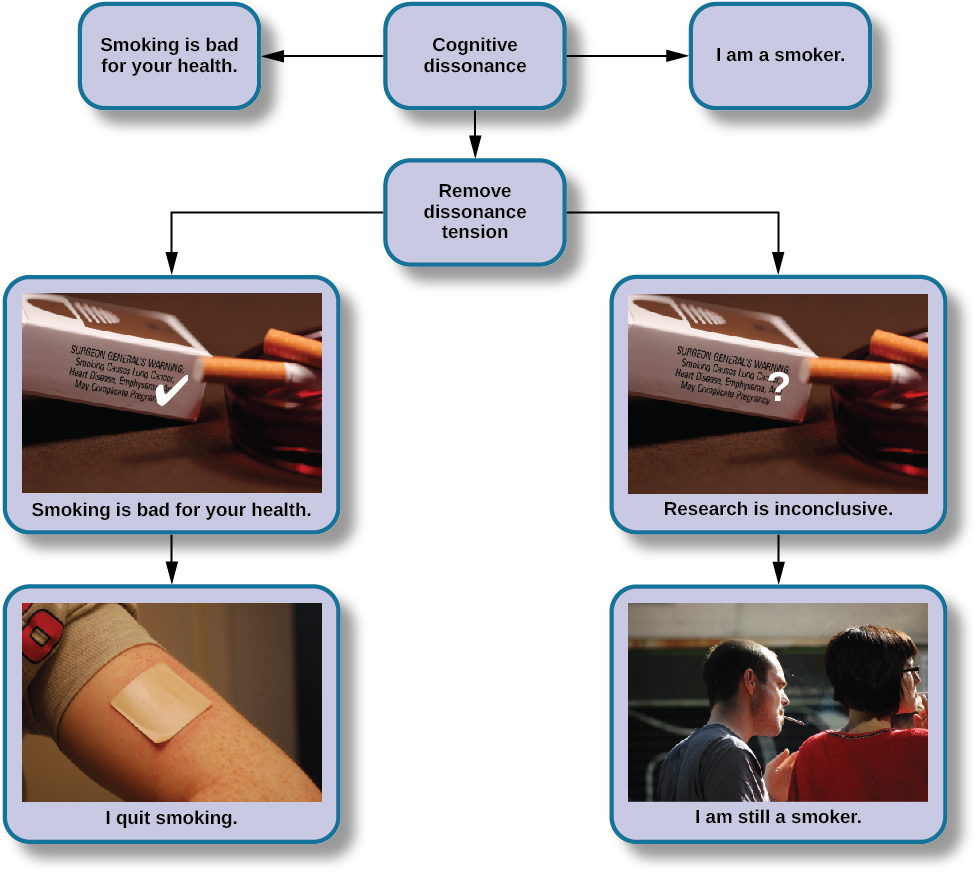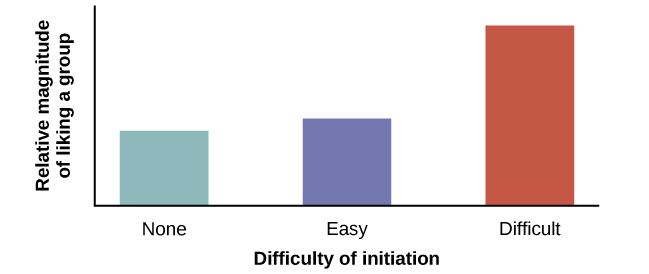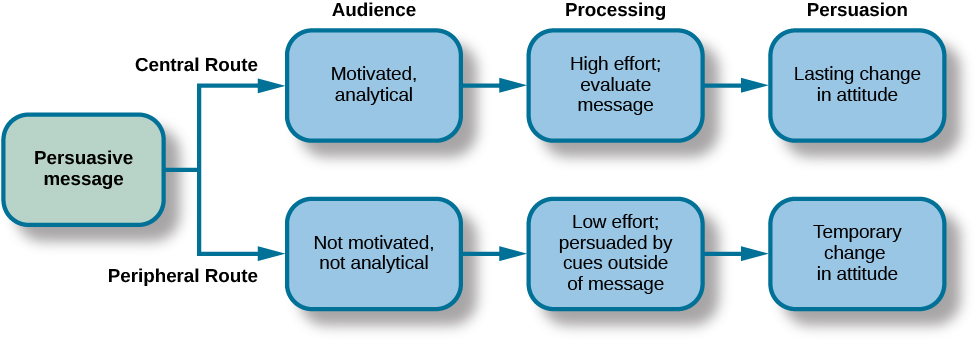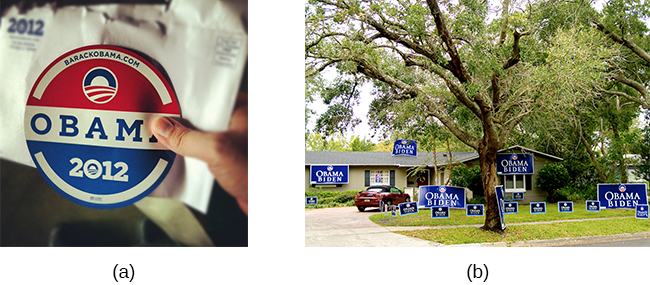111 Attitudes and Persuasion
Learning Objectives
By the end of this section, you will be able to:
- Define attitude
- Describe how people’s attitudes are internally changed through cognitive dissonance
- Explain how people’s attitudes are externally changed through persuasion
- Describe the peripheral and central routes to persuasion
Social psychologists have documented how the power of the situation can influence our behaviours. Now we turn to how the power of the situation can influence our attitudes and beliefs. Attitude is our evaluation of a person, an idea, or an object. We have attitudes for many things ranging from products that we might pick up in the supermarket to people around the world to political policies. Typically, attitudes are favourable or unfavourable: positive or negative (Eagly & Chaiken, 1993). And, they have three components: an affective component (feelings), a behavioural component (the effect of the attitude on behaviour), and a cognitive component (belief and knowledge) (Rosenberg & Hovland, 1960).
For example, you may hold a positive attitude toward recycling. This attitude should result in positive feelings toward recycling (such as “It makes me feel good to recycle” or “I enjoy knowing that I make a small difference in reducing the amount of waste that ends up in landfills”). Certainly, this attitude should be reflected in our behaviour: You actually recycle as often as you can. Finally, this attitude will be reflected in favourable thoughts (for example, “Recycling is good for the environment” or “Recycling is the responsible thing to do”).
Our attitudes and beliefs are not only influenced by external forces, but also by internal influences that we control. Like our behaviour, our attitudes and thoughts are not always changed by situational pressures, but they can be consciously changed by our own free will. In this section we discuss the conditions under which we would want to change our own attitudes and beliefs.
What is Cognitive Dissonance?
Social psychologists have documented that feeling good about ourselves and maintaining positive self-esteem is a powerful motivator of human behaviour (Tavris & Aronson, 2008). In the United States, members of the predominant culture typically think very highly of themselves and view themselves as good people who are above average on many desirable traits (Ehrlinger, Gilovich, & Ross, 2005). Often, our behaviour, attitudes, and beliefs are affected when we experience a threat to our self-esteem or positive self-image. Psychologist Leon Festinger (1957) defined cognitive dissonance as psychological discomfort arising from holding two or more inconsistent attitudes, behaviours, or cognitions (thoughts, beliefs, or opinions). Festinger’s theory of cognitive dissonance states that when we experience a conflict in our behaviours, attitudes, or beliefs that runs counter to our positive self-perceptions, we experience psychological discomfort (dissonance). For example, if you believe smoking is bad for your health but you continue to smoke, you experience conflict between your belief and behaviour (Figure SP.9).

Later research documented that only conflicting cognitions that threaten individuals’ positive self-image cause dissonance (Greenwald & Ronis, 1978). Additional research found that dissonance is not only psychologically uncomfortable but also can cause physiological arousal (Croyle & Cooper, 1983) and activate regions of the brain important in emotions and cognitive functioning (van Veen, Krug, Schooler, & Carter, 2009). When we experience cognitive dissonance, we are motivated to decrease it because it is psychologically, physically, and mentally uncomfortable. We can reduce cognitive dissonance by bringing our cognitions, attitudes, and behaviours in line—that is, making them harmonious. This can be done in different ways, such as:
- changing our discrepant behaviour (e.g., stop smoking),
- changing our cognitions through rationalization or denial (e.g., telling ourselves that health risks can be reduced by smoking filtered cigarettes),
- adding a new cognition (e.g., “Smoking suppresses my appetite so I don’t become overweight, which is good for my health.”).
A classic example of cognitive dissonance is Elian, a 20-year-old who enlists in the military. During boot camp is awakened at 5:00 a.m., is chronically sleep deprived, yelled at, covered in sand flea bites, physically bruised and battered, and mentally exhausted (Figure SP.10). It gets worse. Recruits that make it to week 11 of boot camp have to do 54 hours of continuous training.

Not surprisingly, Elian is miserable. No one likes to be miserable. In this type of situation, people can change their beliefs, their attitudes, or their behaviours. The last option, a change of behaviours, is not available to Elian. He has signed on to the military for four years, and cannot legally leave.
If Elian keeps thinking about how miserable they are, it is going to be a very long four years. Elian will be in a constant state of cognitive dissonance. As an alternative to this misery, Elian can change their beliefs or attitudes. Elian can tell themselves, “I am becoming stronger, healthier, and sharper. I am learning discipline and how to defend myself and my country. What I am doing is really important.” If this is their belief, Elian will realize that they are becoming stronger through their challenges. Then they will feel better and not experience cognitive dissonance, which is an uncomfortable state.
TRICKY TOPIC: COGNITIVE DISSONANCE
If the video above does not load, click here: https://youtu.be/hNEV-RxcKmk
The Effect of Initiation
The military example demonstrates the observation that a difficult initiation into a group influences us to like the group more. Another social psychology concept, justification of effort, suggests that we value goals and achievements that we put a lot of effort into. According to this theory, if something is difficult for us to achieve, we believe it is more worthwhile. For example, if you move to an apartment and spend hours assembling a dresser you bought from Ikea, you will value that more than a fancier dresser your parents bought you. We do not want to have wasted time and effort to join a group that we eventually leave. A classic experiment by Aronson and Mills (1959) demonstrated this justification of effort effect. College students volunteered to join a campus group that would meet regularly to discuss the psychology of sex. Participants were randomly assigned to one of three conditions: no initiation, an easy initiation, and a difficult initiation into the group. After participating in the first discussion, which was deliberately made very boring, participants rated how much they liked the group. Participants who underwent a difficult initiation process to join the group rated the group more favourably than did participants with an easy initiation or no initiation (Figure SP.11).

Besides the classic military example and group initiation, can you think of other examples of cognitive dissonance? Here is one: Addison and Adrian live in Fairfield County, Connecticut, which is one of the wealthiest areas in the United States and has a very high cost of living. Addison telecommutes from home and Adrian does not work outside of the home. They rent a very small house for more than $3000 a month. Adrian shops at consignment stores for clothes and economizes when possible. They complain that they never have any money and that they cannot buy anything new. When asked why they do not move to a less expensive location, since Addison telecommutes, they respond that Fairfield County is beautiful, they love the beaches, and they feel comfortable there. How does the theory of cognitive dissonance apply to Addison and Adrian’s choices?
Persuasion
In the previous section we discussed that the motivation to reduce cognitive dissonance leads us to change our attitudes, behaviours, and/or cognitions to make them consonant. Persuasion is the process of changing our attitude toward something based on some kind of communication. Much of the persuasion we experience comes from outside forces. How do people convince others to change their attitudes, beliefs, and behaviours (Figure SP.12)? What communications do you receive that attempt to persuade you to change your attitudes, beliefs, and behaviours?

Yale Attitude Change Approach
The topic of persuasion has been one of the most extensively researched areas in social psychology (Fiske et al., 2010). During the Second World War, Carl Hovland extensively researched persuasion for the U.S. Army. After the war, Hovland continued his exploration of persuasion at Yale University. Out of this work came a model called the Yale attitude change approach, which describes the conditions under which people tend to change their attitudes. Hovland demonstrated that certain features of the source of a persuasive message, the content of the message, and the characteristics of the audience will influence the persuasiveness of a message (Hovland, Janis, & Kelley, 1953).
Features of the source of the persuasive message include the credibility of the speaker (Hovland & Weiss, 1951) and the physical attractiveness of the speaker (Eagly & Chaiken, 1975; Petty, Wegener, & Fabrigar, 1997). Thus, speakers who are credible, or have expertise on the topic, and who are deemed as trustworthy are more persuasive than less credible speakers. Similarly, more attractive speakers are more persuasive than less attractive speakers. The use of famous actors and athletes to advertise products on television and in print relies on this principle. The immediate and long term impact of the persuasion also depends, however, on the credibility of the messenger (Kumkale & Albarracín, 2004).
Features of the message itself that affect persuasion include subtlety (the quality of being important, but not obvious) (Petty & Cacioppo, 1986; Walster & Festinger, 1962); sidedness (that is, having more than one side) (Crowley & Hoyer, 1994; Igou & Bless, 2003; Lumsdaine & Janis, 1953); timing (Haugtvedt & Wegener, 1994; Miller & Campbell, 1959), and whether both sides are presented. Messages that are more subtle are more persuasive than direct messages. Arguments that occur first, such as in a debate, are more influential if messages are given back-to-back. However, if there is a delay after the first message, and before the audience needs to make a decision, the last message presented will tend to be more persuasive (Miller & Campbell, 1959).
Features of the audience that affect persuasion are attention (Albarracín & Wyer, 2001; Festinger & Maccoby, 1964), intelligence, self-esteem (Rhodes & Wood, 1992), and age (Krosnick & Alwin, 1989). In order to be persuaded, audience members must be paying attention. People with lower intelligence are more easily persuaded than people with higher intelligence; whereas people with moderate self-esteem are more easily persuaded than people with higher or lower self-esteem (Rhodes & Wood, 1992). Finally, younger adults aged 18–25 are more persuadable than older adults.
Elaboration Likelihood Model
An especially popular model that describes the dynamics of persuasion is the elaboration likelihood model of persuasion (Petty & Cacioppo, 1986). The elaboration likelihood model considers the variables of the attitude change approach—that is, features of the source of the persuasive message, contents of the message, and characteristics of the audience are used to determine when attitude change will occur. According to the elaboration likelihood model of persuasion, there are two main routes that play a role in delivering a persuasive message: central and peripheral (Figure SP.13).

The central route is logic driven and uses data and facts to convince people of an argument’s worthiness. For example, a car company seeking to persuade you to purchase their model will emphasize the car’s safety features and fuel economy. This is a direct route to persuasion that focuses on the quality of the information. In order for the central route of persuasion to be effective in changing attitudes, thoughts, and behaviours, the argument must be strong and, if successful, will result in lasting attitude change.
The central route to persuasion works best when the target of persuasion, or the audience, is analytical and willing to engage in processing of the information. From an advertiser’s perspective, what products would be best sold using the central route to persuasion? What audience would most likely be influenced to buy the product? One example is buying a computer. It is likely, for example, that small business owners might be especially influenced by the focus on the computer’s quality and features such as processing speed and memory capacity.
The peripheral route is an indirect route that uses peripheral cues to associate positivity with the message (Petty & Cacioppo, 1986). Instead of focusing on the facts and a product’s quality, the peripheral route relies on association with positive characteristics such as positive emotions and celebrity endorsement. For example, having a popular athlete advertise athletic shoes is a common method used to encourage young adults to purchase the shoes. This route to attitude change does not require much effort or information processing. This method of persuasion may promote positivity toward the message or product, but it typically results in less permanent attitude or behaviour change. The audience does not need to be analytical or motivated to process the message. In fact, a peripheral route to persuasion may not even be noticed by the audience, for example in the strategy of product placement. Product placement refers to putting a product with a clear brand name or brand identity in a TV show or movie to promote the product (Gupta & Lord, 1998). For example, one season of the reality series American Idol prominently showed the panel of judges drinking out of cups that displayed the Coca-Cola logo. What other products would be best sold using the peripheral route to persuasion? Another example is clothing: A retailer may focus on celebrities that are wearing the same style of clothing.
Foot-in-the-door Technique
Researchers have tested many persuasion strategies that are effective in selling products and changing people’s attitude, ideas, and behaviours. One effective strategy is the foot-in-the-door technique (Cialdini, 2001; Pliner, Hart, Kohl, & Saari, 1974). Using the foot-in-the-door technique, the persuader gets a person to agree to bestow a small favour or to buy a small item, only to later request a larger favour or purchase of a bigger item. The foot-in-the-door technique was demonstrated in a study by Freedman and Fraser (1966) in which participants who agreed to post small sign in their yard or sign a petition were more likely to agree to put a large sign in their yard than people who declined the first request (Figure SP.14). Research on this technique also illustrates the principle of consistency (Cialdini, 2001): Our past behaviour often directs our future behaviour, and we have a desire to maintain consistency once we have a committed to a behaviour.

A common application of foot-in-the-door is when teens ask their parents for a small permission (for example, extending curfew by a half hour) and then asking them for something larger. Having granted the smaller request increases the likelihood that parents will acquiesce with the later, larger request.
How would a store owner use the foot-in-the-door technique to sell you an expensive product? For example, say that you are buying the latest model smartphone, and the salesperson suggests you purchase the best data plan. You agree to this. The salesperson then suggests a bigger purchase—the three-year extended warranty. After agreeing to the smaller request, you are more likely to also agree to the larger request. You may have encountered this if you have bought a car. When salespeople realize that a buyer intends to purchase a certain model, they might try to get the customer to pay for many or most available options on the car. Another example of the foot-in-the-door technique would be applied to an individual in the market for a used car who decides to buy a fully loaded new car. Why? Because the salesperson convinced the buyer that they need a car that has all of the safety features that were not available in the used car.

